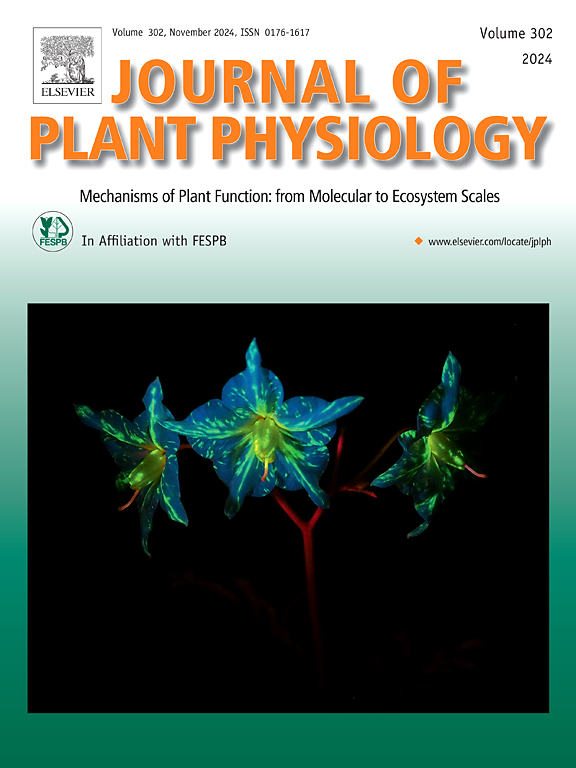Cloning the promoter of the sucrose transporter gene PsSUT2 and screening its upstream transcription factors in tree peony
IF 4
3区 生物学
Q1 PLANT SCIENCES
引用次数: 0
Abstract
Sucrose is an essential energy substance for tree peony (Paeonia Suffruticosa) floral organ development. However, little is known about the sucrose regulatory network in tree peony. In this study, the promoter sequence of the tree peony sucrose transporter gene PsSUT2 was cloned. Through cis-acting elements analysis and weighted gene co-expression network analysis (WGCNA), 6 transcription factors potentially regulating PsSUT2 were screened. Expression analysis revealed that the 6 transcription factors had similar expression trends with the PsSUT2 in all parts of peony at the full bloom stage. Furthermore, a yeast one-hybrid assay revealed that PsMYB20 and PsMADS9 bind to the PsSUT2 promoter. Dual-luciferase reporter assay demonstrated that PsMYB20 and PsMADS9 could activate PsSUT2 expression. Taken together, our findings suggest that PsMYB20 and PsMADS9 positively regulate PsSUT2, laying the foundation for the construction of a gene network for sucrose regulation in tree peony.
牡丹蔗糖转运基因PsSUT2启动子的克隆及其上游转录因子的筛选。
蔗糖是芍药花器官发育所必需的能量物质。然而,对牡丹的蔗糖调控网络知之甚少。本研究克隆了牡丹蔗糖转运体基因PsSUT2的启动子序列。通过顺式作用元件分析和加权基因共表达网络分析(WGCNA),筛选出6个可能调控PsSUT2的转录因子。表达分析表明,这6个转录因子与PsSUT2在牡丹盛花期各部位的表达趋势相似。此外,酵母单杂交实验显示PsMYB20和PsMADS9与PsSUT2启动子结合。双荧光素酶报告基因实验表明PsMYB20和PsMADS9能够激活PsSUT2的表达。综上所述,我们的研究结果表明PsMYB20和PsMADS9正调控PsSUT2,为构建牡丹蔗糖调控基因网络奠定了基础。
本文章由计算机程序翻译,如有差异,请以英文原文为准。
求助全文
约1分钟内获得全文
求助全文
来源期刊

Journal of plant physiology
生物-植物科学
CiteScore
7.20
自引率
4.70%
发文量
196
审稿时长
32 days
期刊介绍:
The Journal of Plant Physiology is a broad-spectrum journal that welcomes high-quality submissions in all major areas of plant physiology, including plant biochemistry, functional biotechnology, computational and synthetic plant biology, growth and development, photosynthesis and respiration, transport and translocation, plant-microbe interactions, biotic and abiotic stress. Studies are welcome at all levels of integration ranging from molecules and cells to organisms and their environments and are expected to use state-of-the-art methodologies. Pure gene expression studies are not within the focus of our journal. To be considered for publication, papers must significantly contribute to the mechanistic understanding of physiological processes, and not be merely descriptive, or confirmatory of previous results. We encourage the submission of papers that explore the physiology of non-model as well as accepted model species and those that bridge basic and applied research. For instance, studies on agricultural plants that show new physiological mechanisms to improve agricultural efficiency are welcome. Studies performed under uncontrolled situations (e.g. field conditions) not providing mechanistic insight will not be considered for publication.
The Journal of Plant Physiology publishes several types of articles: Original Research Articles, Reviews, Perspectives Articles, and Short Communications. Reviews and Perspectives will be solicited by the Editors; unsolicited reviews are also welcome but only from authors with a strong track record in the field of the review. Original research papers comprise the majority of published contributions.
 求助内容:
求助内容: 应助结果提醒方式:
应助结果提醒方式:


